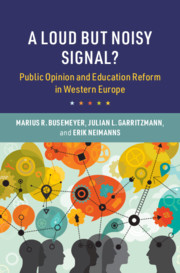56 results
8 - All about the Middle Class?
- from Part II - Representation and Responsiveness in Unequal Societies
-
-
- Book:
- Contested Representation
- Published online:
- 03 November 2022
- Print publication:
- 17 November 2022, pp 129-146
-
- Chapter
- Export citation
Fiscal policy preferences, trade-offs, and support for social investment
-
- Journal:
- Journal of Public Policy / Volume 42 / Issue 4 / December 2022
- Published online by Cambridge University Press:
- 27 May 2022, pp. 684-704
-
- Article
-
- You have access
- Open access
- HTML
- Export citation
Social Investment, Redistribution or Basic Income? Exploring the Association Between Automation Risk and Welfare State Attitudes in Europe
-
- Journal:
- Journal of Social Policy / Volume 51 / Issue 4 / October 2022
- Published online by Cambridge University Press:
- 12 July 2021, pp. 751-770
- Print publication:
- October 2022
-
- Article
-
- You have access
- Open access
- HTML
- Export citation
Part II - Qualitative Evidence: The Role of Public Opinion in Education Reforms in Western Europe
-
- Book:
- A Loud but Noisy Signal?
- Published online:
- 14 September 2020
- Print publication:
- 03 September 2020, pp 153-307
-
- Chapter
- Export citation
2 - Theoretical Framework
-
- Book:
- A Loud but Noisy Signal?
- Published online:
- 14 September 2020
- Print publication:
- 03 September 2020, pp 17-52
-
- Chapter
- Export citation
Copyright page
-
- Book:
- A Loud but Noisy Signal?
- Published online:
- 14 September 2020
- Print publication:
- 03 September 2020, pp iv-iv
-
- Chapter
- Export citation
5 - Germany
- from Part II - Qualitative Evidence: The Role of Public Opinion in Education Reforms in Western Europe
-
- Book:
- A Loud but Noisy Signal?
- Published online:
- 14 September 2020
- Print publication:
- 03 September 2020, pp 157-204
-
- Chapter
- Export citation
4 - Attitudes on Education Governance in Western Europe
- from Part I - Quantitative Evidence: Attitudes, Public Opinion, and Politics
-
- Book:
- A Loud but Noisy Signal?
- Published online:
- 14 September 2020
- Print publication:
- 03 September 2020, pp 100-152
-
- Chapter
- Export citation
1 - Introduction
-
- Book:
- A Loud but Noisy Signal?
- Published online:
- 14 September 2020
- Print publication:
- 03 September 2020, pp 1-16
-
- Chapter
- Export citation
3 - Attitudes on Education Spending in Western Europe
- from Part I - Quantitative Evidence: Attitudes, Public Opinion, and Politics
-
- Book:
- A Loud but Noisy Signal?
- Published online:
- 14 September 2020
- Print publication:
- 03 September 2020, pp 57-99
-
- Chapter
- Export citation
Contents
-
- Book:
- A Loud but Noisy Signal?
- Published online:
- 14 September 2020
- Print publication:
- 03 September 2020, pp v-vi
-
- Chapter
- Export citation
References
-
- Book:
- A Loud but Noisy Signal?
- Published online:
- 14 September 2020
- Print publication:
- 03 September 2020, pp 327-360
-
- Chapter
- Export citation
Preface and Acknowledgments
-
- Book:
- A Loud but Noisy Signal?
- Published online:
- 14 September 2020
- Print publication:
- 03 September 2020, pp xiii-xvi
-
- Chapter
- Export citation
Tables
-
- Book:
- A Loud but Noisy Signal?
- Published online:
- 14 September 2020
- Print publication:
- 03 September 2020, pp xi-xii
-
- Chapter
- Export citation
8 - Spain
- from Part II - Qualitative Evidence: The Role of Public Opinion in Education Reforms in Western Europe
-
- Book:
- A Loud but Noisy Signal?
- Published online:
- 14 September 2020
- Print publication:
- 03 September 2020, pp 275-307
-
- Chapter
- Export citation
7 - England
- from Part II - Qualitative Evidence: The Role of Public Opinion in Education Reforms in Western Europe
-
- Book:
- A Loud but Noisy Signal?
- Published online:
- 14 September 2020
- Print publication:
- 03 September 2020, pp 240-274
-
- Chapter
- Export citation
Index
-
- Book:
- A Loud but Noisy Signal?
- Published online:
- 14 September 2020
- Print publication:
- 03 September 2020, pp 361-365
-
- Chapter
- Export citation
Part I - Quantitative Evidence: Attitudes, Public Opinion, and Politics
-
- Book:
- A Loud but Noisy Signal?
- Published online:
- 14 September 2020
- Print publication:
- 03 September 2020, pp 53-152
-
- Chapter
- Export citation
9 - Comparative Summary and Conclusions
-
- Book:
- A Loud but Noisy Signal?
- Published online:
- 14 September 2020
- Print publication:
- 03 September 2020, pp 308-326
-
- Chapter
- Export citation

A Loud but Noisy Signal?
- Public Opinion and Education Reform in Western Europe
-
- Published online:
- 14 September 2020
- Print publication:
- 03 September 2020



